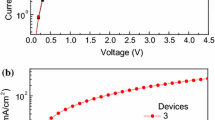Abstract
For investigating the effect of inserting a hole injection layer (HIL), we carried out a computational study concerning organic light-emitting diodes (OLEDs) that had a thin CuPc layer as the hole injection layer. We used S-TAD (2, 2’, 7, 7’-tetrakis-(N, Ndiphenylamino)-9, 9-spirobifluoren) for the hole transfer layer, S-DPVBi (4, 4’-bis (2, 2’-diphenylvinyl)-1, 1’-spirobiphenyl) for the emission layer and Alq3 (Tris (8-hyroxyquinolinato) aluminium) for the electron transfer layer. This tri-layer device was compared with four-layer devices. To this tri-layer device, we added a thin CuPc layer, which had a 5.3 eV highest occupied molecular orbital (HOMO) level and a 3.8 eV lowest unoccupied molecular orbital (LUMO) level, as a hole injection layer, and we chose this device for Device A. Also, we varied the LUMO level or the HOMO level of the thin CuPc layer. These two devices were identified as Device C and Device D, respectively. In this paper, we simulated the carrier injection, transport and recombination in these four devices. Thereby, we showed the effect of the HIL, and we demonstrated that the characteristics of these devices were improved by adding a thin layer of CuPc between the anode and the HTL.
Similar content being viewed by others
References
K. S. Kim, Y. W. Hwang and T. Y. Won, Adv. Mater. Res. 629, 244 (2013).
K. Neyts, Appl. Surf. Sci. 244, 517 (2005).
B. Ruhstaller, T. Beierlein, H. Riel, S. Karg, J. C. Scott and W. Riess, Sel. Top. Quantum Electron. J. IEEE 9, 723 (2003).
B. Ruhstaller, S. Carter, S. Barth, H. Riel, W. Riess and J. Scott, J. Appl. Phys. 89, 4575 (2001).
V. Y. Aristov, O. Molodtsova, V. Zhilin, D. Vyalikh and M. Knupfer, Phys. Rev. B 72, 165318 (2005).
J. Gao, J. Xu, M. Zhu, N. Ke and D. Ma, J. Phys. D 40, 5666 (2007).
Y. Hsiao, W. Whang, S. Suen, J. Shiu and C. Chen, Nanotechnology 19, 415603 (2008).
F. Reis, D. Mencaraglia, S. Oould Saad, I. Séguy, M. Oukachmih, P. Jolinat and P. Destruel, Synth. Met. 138, 33 (2003).
S. Tadayyon, H. Grandin, K. Griffiths, P. Norton, H. Aziz and Z. Popovic, Organic Electronics 5, 157 (2004).
Author information
Authors and Affiliations
Corresponding author
Rights and permissions
About this article
Cite this article
Lee, H., Hwang, Y. & Won, T. Effect of inserting a hole injection layer in organic light-emitting diodes: A numerical approach. Journal of the Korean Physical Society 66, 100–103 (2015). https://doi.org/10.3938/jkps.66.100
Received:
Accepted:
Published:
Issue Date:
DOI: https://doi.org/10.3938/jkps.66.100




